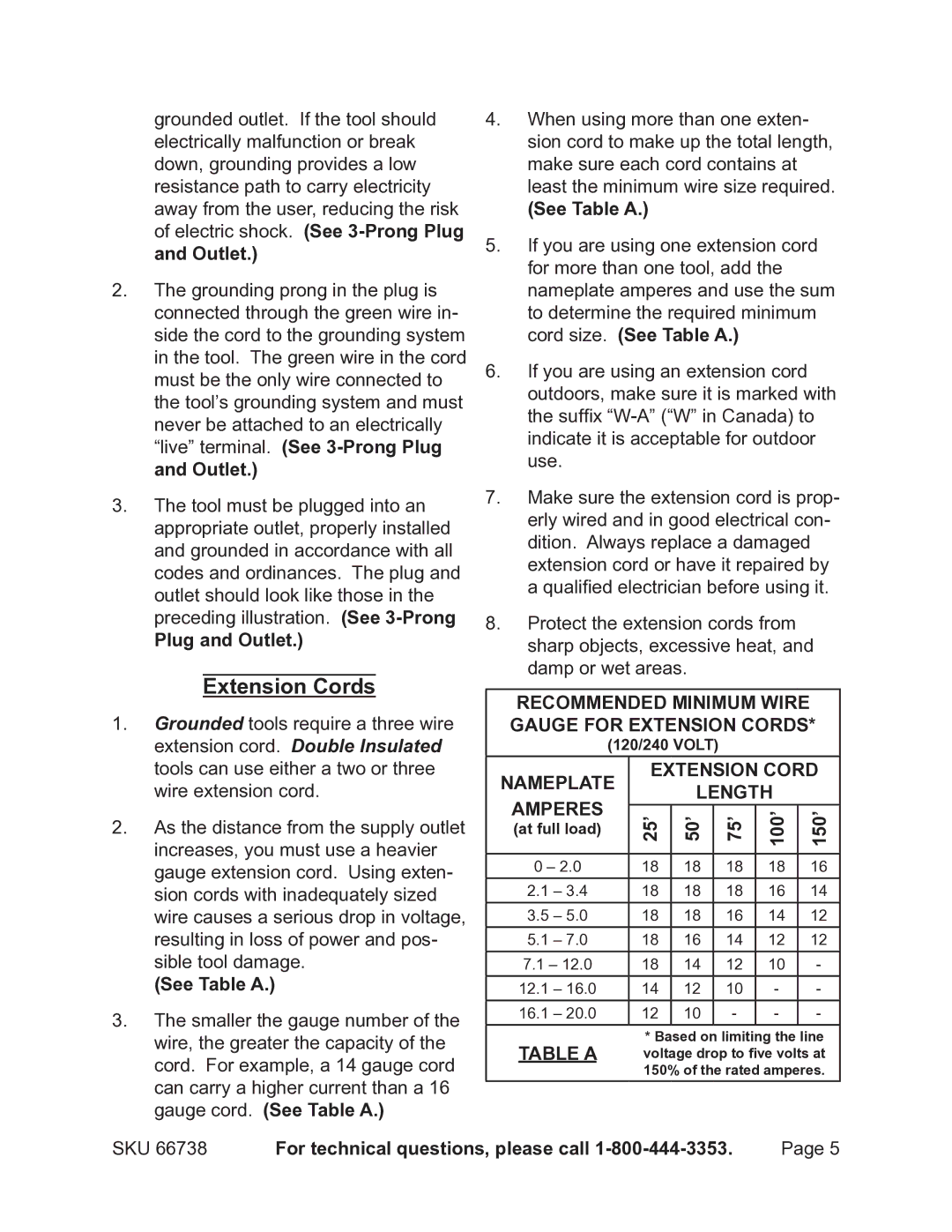| grounded outlet. If the tool should | 4. | When using more than one exten- | ||||||||||
| electrically malfunction or break |
| sion cord to make up the total length, | ||||||||||
| down, grounding provides a low |
| make sure each cord contains at |
| |||||||||
| resistance path to carry electricity |
| least the minimum wire size required. | ||||||||||
| away from the user, reducing the risk |
| (See Table A.) |
|
|
|
|
| |||||
| of electric shock. (See | 5. | If you are using one extension cord | ||||||||||
| and Outlet.) |
|
|
| for more than one tool, add the |
| |||||||
|
|
|
|
|
|
| |||||||
2. The grounding prong in the plug is |
| nameplate amperes and use the sum | |||||||||||
| connected through the green wire in- |
| to determine the required minimum | ||||||||||
| side the cord to the grounding system |
| cord size. (See Table A.) |
|
| ||||||||
| in the tool. The green wire in the cord | 6. | If you are using an extension cord | ||||||||||
| must be the only wire connected to |
| outdoors, make sure it is marked with | ||||||||||
| the tool’s grounding system and must |
| |||||||||||
|
| the suffix | |||||||||||
| never be attached to an electrically |
| |||||||||||
|
| indicate it is acceptable for outdoor | |||||||||||
| “live” terminal. (See |
| |||||||||||
|
| use. |
|
|
|
|
|
|
| ||||
| and Outlet.) |
|
|
|
|
|
|
|
|
|
| ||
|
|
|
|
|
|
|
|
|
|
|
| ||
3. | The tool must be plugged into an | 7. | Make sure the extension cord is prop- | ||||||||||
| erly wired and in good electrical con- | ||||||||||||
| appropriate outlet, properly installed |
| |||||||||||
|
| dition. Always replace a damaged | |||||||||||
| and grounded in accordance with all |
| |||||||||||
|
| extension cord or have it repaired by | |||||||||||
| codes and ordinances. The plug and |
| |||||||||||
|
| a qualified electrician before using it. | |||||||||||
| outlet should look like those in the |
| |||||||||||
|
|
|
|
|
|
|
|
|
| ||||
| preceding illustration. (See | 8. | Protect the extension cords from |
| |||||||||
| Plug and Outlet.) |
| sharp objects, excessive heat, and | ||||||||||
|
|
|
|
|
| damp or wet areas. |
|
|
| ||||
|
| Extension Cords |
|
|
|
|
|
|
|
|
|
| |
|
|
|
| RECOMMENDED MINIMUM WIRE | |||||||||
1. Grounded tools require a three wire |
| ||||||||||||
| GAUGE FOR EXTENSION CORDS* | ||||||||||||
| extension cord. Double Insulated |
|
| (120/240 VOLT) |
|
|
| ||||||
| tools can use either a two or three | NAMEPLATE | EXTENSION CORD | ||||||||||
| wire extension cord. |
| LENGTH |
| |||||||||
|
| AMPERES |
|
|
| ||||||||
2. As the distance from the supply outlet |
|
| 25’ | 50’ |
| 75’ | 100’ | 150’ | |||||
| (at full load) |
|
| ||||||||||
| increases, you must use a heavier |
|
|
|
| ||||||||
|
|
|
|
|
|
|
|
|
| ||||
|
| 0 – 2.0 |
| 18 | 18 |
| 18 | 18 | 16 | ||||
| gauge extension cord. Using exten- |
|
|
| |||||||||
| sion cords with inadequately sized |
| 2.1 – 3.4 |
| 18 | 18 |
| 18 | 16 | 14 | |||
| wire causes a serious drop in voltage, |
| 3.5 – 5.0 |
| 18 | 18 |
| 16 | 14 | 12 | |||
| resulting in loss of power and pos- |
| 5.1 – 7.0 |
| 18 | 16 |
| 14 | 12 | 12 | |||
| sible tool damage. |
| 7.1 – 12.0 |
| 18 | 14 |
| 12 | 10 | - | |||
| (See Table A.) |
|
|
|
|
|
|
|
|
|
|
| |
|
|
|
| 12.1 – 16.0 |
| 14 | 12 |
| 10 | - | - | ||
3. | The smaller the gauge number of the |
| 16.1 – 20.0 |
| 12 | 10 |
| - | - | - | |||
|
|
| * Based on limiting the line | ||||||||||
| wire, the greater the capacity of the |
| TABLE A |
| |||||||||
| cord. For example, a 14 gauge cord |
|
| voltage drop to five volts at | |||||||||
|
|
|
| 150% of the rated amperes. | |||||||||
| can carry a higher current than a 16 |
|
|
|
|
|
|
|
|
| |||
|
|
|
|
|
|
|
|
|
| ||||
| gauge cord. (See Table A.) |
|
|
|
|
|
|
|
|
| |||
SKU 66738 | For technical questions, please call | Page 5 | |||||||||||
Page 5
Image 5
